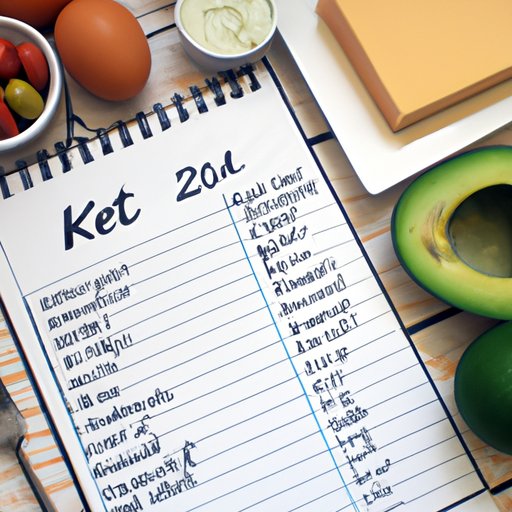
I. Introduction
The keto diet plan has gained popularity in recent years due to its effectiveness in weight loss and other health benefits. In this article, we will take a deep dive into the keto diet plan, including its definition, how it works, what to eat and avoid, meal planning, scientific research and studies, and weight loss tips. The purpose of this article is to provide a comprehensive guide for those considering adopting the keto diet plan, as well as beginners looking for a starting point.
II. A Beginner’s Guide to the Keto Diet Plan: Understanding the Basics
The keto diet plan is a high-fat, low-carb diet technique that aims to put the body into ketosis, a metabolic state where the body uses fat as a primary source of energy instead of carbohydrates.
In ketosis, the liver breaks down stored fats into molecules called ketone bodies, which the body uses as fuel. To achieve ketosis, the keto diet plan usually requires reducing carbohydrate consumption to less than 50 grams per day, depending on the individual’s goals and needs.
Foods to eat include natural fats, such as butter, avocado, olive oil, and coconut oil, as well as protein from meat, fish, and eggs. On the other hand, foods to avoid include sugary and starchy foods, grains, fruits, and most types of processed foods.
If you’re a beginner starting on the keto diet plan, it’s essential to take it slow and ease into it. The sudden carbohydrate restriction may cause side effects such as headaches, dizziness, irritability, and fatigue. Be sure to consult your healthcare provider before starting the keto diet plan.
III. Keto 101: All You Need to Know about the Ketogenic Diet Plan
The keto diet plan originated as a medical treatment for epilepsy in the early 1920s. The diet plan’s popularity soared in the 1990s among bodybuilders and athletes seeking to achieve fat loss and lean muscle growth.
There are several types of the keto diet plan, including the standard ketogenic diet, cyclical ketogenic diet, targeted ketogenic diet, high-protein keto diet, and vegan keto diet. Each variation of the diet plan has specific requirements and restrictions.
Research shows that the keto diet plan may have multiple health benefits, including weight loss, improved heart health, better cognitive function, and reducing the risk of certain types of cancer and neurological disorders.
However, the keto diet plan also has several drawbacks, such as the difficulty of maintaining it for an extended period and the risk of nutrient deficiencies due to the restricted food choices.
IV. The Science Behind the Keto Diet Plan: How It Works and Benefits
Ketosis is a metabolic state where the body runs out of glucose, its primary source of energy. In the absence of glucose, the liver starts breaking down stored fats into ketones, which can serve as an alternative fuel source for the body.
The keto diet plan’s effects on the body include significantly reducing insulin secretion, making it easier for fat to be released from the body’s fat stores. The diet plan also promotes the use of ketones as fuel, which can potentially improve brain function and cognitive performance.
Studies have shown that the keto diet plan can lead to rapid weight loss in the short term. However, it’s important to note that the weight loss is primarily due to water loss and depletion of glycogen stores in the muscles. Sustainable weight loss on the keto diet plan requires calorie restriction and a healthy, balanced diet.
V. A Day in the Life of a Keto Dieter: What to Eat, Avoid, and How to Succeed
A typical day on the keto diet plan may include eggs and avocado for breakfast, a salad with chicken or fish for lunch, and a steak or salmon with broccoli for dinner.
Snacks can include nuts, cheese, and vegetables with hummus. It’s important to avoid sugary and starchy foods such as candy, bread, pasta, and potatoes.
To succeed on the keto diet plan, it’s important to plan your meals and snacks ahead of time and incorporate healthy fats and protein in each meal. It’s also important to drink plenty of water to stay hydrated.
Common mistakes to avoid include eating too much protein, not getting enough fiber, and not consuming enough electrolytes.
VI. Keto Meal Planning: Delicious Recipes and Easy Meal Ideas
Keto-friendly meal and snack options include cheese and spinach omelets, bacon-wrapped asparagus, cauliflower rice stir fry, and chocolate avocado pudding.
Meal planning and preparation are crucial to succeeding on the keto diet plan. Focus on incorporating healthy fats and proteins while limiting carbohydrate intake in each meal.
VII. The Keto Diet Plan and Weight Loss: What to Expect and How to Stay on Track
The keto diet plan can lead to rapid weight loss in the short term, primarily due to water loss and glycogen depletion. For sustainable weight loss on the keto diet plan, calorie restriction and a healthy, balanced diet are essential.
It’s important to track your progress, including your weight, body measurements, and macros, to ensure you’re staying on track with your goals.
If you hit a weight loss plateau while on the keto diet plan, it may be helpful to adjust your calorie intake or try incorporating more physical activity into your routine.
VIII. Conclusion
The keto diet plan can provide numerous health benefits, including weight loss and improved cognitive function. However, the diet plan requires strict adherence to the recommended macronutrient ratios and can be challenging to maintain in the long term.
If you’re considering adopting the keto diet plan, be sure to consult your healthcare provider to determine if it’s an appropriate dietary strategy for your needs and goals. Remember to take it slow and ease into the diet plan to avoid potential side effects. With meal planning, preparation, and the right mindset, you can set yourself up for success on the keto diet plan.





